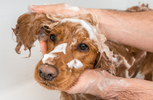
The Dirty Truth About Pet Grooming Products
, by Majella Gee, 14 min reading time

, by Majella Gee, 14 min reading time
The Dirty Truth About Pet Grooming Products: What You're Really Exposing Your Pet (and Yourself) To.
We all want our pets to look and feel their best, whether it's after a trip to the groomer or a pampering session at home. But beneath the sweet-smelling shampoos, glossy conditioners, and spritzes of doggy perfume lies a hidden danger—one that affects not only your furry friend but you as well.

The Problem With Common Grooming Products
Pet grooming products—especially those widely used in salons and sold for home use—often contain a cocktail of synthetic chemicals, artificial fragrances, and preservatives. These substances may give the illusion of cleanliness and care, but many have well-documented links to allergies, chronic illness, and even cancer.
Common Grooming Products:

Toxic Ingredients to Watch Out For
Here are just a few of the usual suspects found in many commercial grooming products:
1. Formaldehyde & Formaldehyde-Releasing Preservatives
Used to prolong shelf life, these can cause skin irritation, allergic reactions, and respiratory distress. Long-term exposure may be carcinogenic. Watch for ingredients like Diazolidinyl urea, Imidazolidinyl urea, and Quaternium-15—these are all formaldehyde releasers.
2. Sodium Lauryl Sulfate (SLS) & Sodium Laureth Sulfate (SLES)
Found in shampoos for their foaming action, these strip natural oils and irritate skin, leaving pets vulnerable to allergens and pathogens. Sometimes listed under alternative names such as sodium dodecyl sulfate or simply “sulfates.”
3. Parabens
Used as preservatives, parabens are known endocrine disruptors and may interfere with hormone function in both pets and humans. Look out for methylparaben, propylparaben, and butylparaben.
4. Phthalates
Common in synthetic fragrances, phthalates are linked to reproductive issues, liver toxicity, and developmental problems. Often hidden under the term "fragrance" or "parfum."
5. Isothiazolinones (e.g., Methylisothiazolinone)
Preservatives with neurotoxic potential, often responsible for allergic reactions and dermatitis. Also appears as chloromethylisothiazolinone and benzisothiazolinone.
6. Pyrethrins/Pyrethroids
Found in flea rinses and collars, these insecticides are highly toxic to cats and can cause tremors, seizures, and even death.
7. Talc
Used in dry shampoos and powders, talc can contain asbestos-like fibres that pose respiratory risks to both pets and humans.
8. Butane, Isobutane, Propane
Propellants used in sprays and dry shampoos that can cause respiratory irritation or central nervous system damage when inhaled regularly.

The Long-Term Impact
These ingredients don’t just cause immediate discomfort. Prolonged exposure—especially for animals groomed regularly—can lead to:
And let’s not forget the pet owners. When you apply these products, you absorb toxins through your own skin, inhale aerosols, and expose your home environment to a build-up of harmful residues.
The Essential Oil Disclaimer
While some natural alternatives exist, essential oils are not always safe either. The quality and source of essential oils make a huge difference. Many oils on the market are synthetic or diluted with chemical carriers, which can be just as harmful—if not worse—than the toxins they aim to replace. Poor-quality essential oils have been known to cause burns, liver toxicity, and respiratory issues in pets and people alike. Always seek professional guidance and ensure oils are of the highest, most therapeutic-grade purity before use.

Over-Grooming: When Clean Becomes Dangerous
Grooming too frequently can actually harm your pet. Frequent washing strips away the skin’s natural oils, leaving it dry, irritated, and more susceptible to infection and allergens. It can disrupt the microbiome of the skin, the body’s first line of defence.
This is especially true for sensitive species like:
What You Can Do

Final Thoughts
Our pets rely on us to make informed decisions. Just because a product is sold on a shelf or used in a grooming salon doesn’t mean it’s safe. The grooming industry is largely unregulated, and marketing terms like “natural” or “vet-approved” don’t always mean what we think they do.
So next time you reach for that bottle of shampoo or spritz of “puppy perfume,” pause and think: what’s really in this—and who’s it really affecting?
Better yet, go grab the bottles already in your cupboard. Flip them over, read the labels, and look up anything unfamiliar. You may be surprised by what you find.
Your pet's health—and your own—may depend on it.
©Majella Gee 2025
#ToxicTruth #PetGroomingAwareness #PetHealthMatters #CheckTheLabel #SafePetCare
#NaturalPetCare #HealthyPetsHappyHumans #PetWellness #GroomingProductsExposed
#HiddenPetDangers #PetCareTips #ProtectYourPet #PetParenting #SayNoToToxins
#EcoFriendlyPetCare #AnimalWellbeing #LabelCheckChallenge #MindfulPetCare
#PetsAreFamily #MajellasPetStore